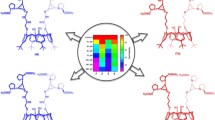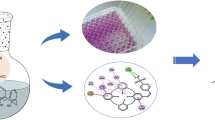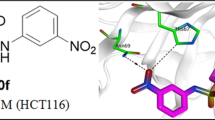Abstract
Here, new calixarene sulfonamide analogs were synthesized from the reaction of chlorosulfonated calix[n]arene (n: 4, 6, and 8) with N,N′-dimethylethylenediamine or ethylenediamine for the first time and an excellent calixarene sulfonamide analog showing potent and selective cytotoxic activity on some cancer cell lines were discovered. Cytotoxicity of the prepared calix[n]arene sulfonamide analogs towards both cancer and healthy cell lines was assessed by performing cell growth inhibition assays. In cytotoxicity assay results, it was observed that while sulfonamide analog based calix[4]arene (9) was not affecting the growth of epithelial cell lines (HEK), and it was especially effective on inhibiting the growth of some human cancer cell lines (MCF-7 and MIA PaCa-2). These results highlight that sulfonamide analog–based calix [4] arene (9) can be further studied as a potential anticancer agent.





Similar content being viewed by others
References
Yousaf, A., Hamid, S. A., Bunnori, N. M., & Ishola, A. A. (2015). Applications of calixarenes in cancer chemotherapy: facts and perspectives. Drug Design, Development and Therapy, 9, 2831–2838.
Drews, J. (2000). Drug discovery: a historical perspective. Science, 287(5460), 1960–1964.
Supuran, C. T., & Scozzafava, A. (2000). Carbonic anhydrase inhibitors and their therapeutic potential. Expert Opinion on Therapeutic Patents, 10(5), 575–600.
Supuran, C. T., & Scozzafava, A. (2002). Applications of carbonic anhydrase inhibitors and activators in therapy. Expert Opinion on Therapeutic Patents, 12(2), 217–242.
Alyar, S., Şen, T., Özmen, Ü. Ö., Alyar, H., Adem, Ş., & Şen, C. (2019). Synthesis, spectroscopic characterizations, enzyme inhibition, molecular docking study and DFT calculations of new Schiff bases of sulfa drugs. Journal of Molecular Structure, 1185, 416–424.
Noubigh, A., & Akremi, A. (2019). Solution thermodynamics of trans-cinnamic acid in (methanol+ water) and (ethanol+ water) mixtures at different temperatures. Journal of Molecular Liquids, 274, 752–758.
Casini, A., Scozzafava, A., & Supuran, C. T. (2002). Sulfonamide derivatives with protease inhibitory action as anticancer, anti-inflammatory and antiviral agents. Expert Opinion on Therapeutic Patents, 12(9), 1307–1327.
Jacobsen, E. J., & Skaletzky, L. L. (1999). U.S. Patent No. 5,859,061. Washington, DC: U.S. Patent and Trademark Office.
Andresen, B. M., Hammen, P. D., & Hawkins, J. M. (2000). U.S. Patent No. 6,114,568. Washington, DC: U.S. Patent and Trademark Office.
Capasso, C., & Supuran, C. T. (2014). Sulfa and trimethoprim-like drugs–antimetabolites acting as carbonic anhydrase, dihydropteroate synthase and dihydrofolate reductase inhibitors. Journal of Enzyme Inhibition and Medicinal Chemistry, 29(3), 379–387.
Muthuramalingam, M., White, J. C., Murphy, T., Ames, J. R., & Bourne, C. R. (2019). The toxin from a ParDE toxin-antitoxin system found in Pseudomonas aeruginosa offers protection to cells challenged with anti-gyrase antibiotics. Molecular Microbiology, 111(2), 441–454.
Han, T., Goralski, M., Gaskill, N., Capota, E., Kim, J., Ting, T. C., & Nijhawan, D. (2017). Anticancer sulfonamides target splicing by inducing RBM39 degradation via recruitment to DCAF15. Science, 356(6336), eaal3755.
Gutsche, C. D., & Nam, K. C. (1988). Calixarenes. 22. Synthesis, properties, and metal complexation of aminocalixarenes. Journal of the American Chemical Society, 110(18), 6153–6162.
Sharma, V. S., Singh, H. K., Vekariya, R. H., Sharma, A. S., & Patel, R. B. (2017). Mesomorphic properties of novel supramolecular calix [4] arene Schiff base ester derivatives: design and biological investigation. ChemistrySelect, 2(27), 8596–8606.
Hussain, M. A., Ashraf, M. U., Muhammad, G., Tahir, M. N., & Bukhari, S. N. A. (2017). Calixarene: a versatile material for drug design and applications. Current Pharmaceutical Design, 23(16), 2377–2388.
Consoli, G. M., Granata, G., Galante, E., Di Silvestro, I., Salafia, L., & Geraci, C. (2007). Synthesis of water-soluble nucleotide-calixarene conjugates and preliminary investigation of their in vitro DNA replication inhibitory activity. Tetrahedron, 63(44), 10758–10763.
Consoli, G. M. L., Granata, G., Picciotto, R., Blanco, A. R., Geraci, C., Marino, A., & Nostro, A. (2018). Design, synthesis and antibacterial evaluation of a polycationic calix [4] arene derivative alone and in combination with antibiotics. MedChemComm, 9(1), 160–164.
Lamartine, R., Tsukada, M., Wilson, D., & Shirata, A. (2002). Antimicrobial activity of calixarenes. Comptes Rendus Chimie, 5(3), 163–169.
Dings, R. P., Miller, M. C., Nesmelova, I., Astorgues-Xerri, L., Kumar, N., Serova, M., & Mayo, K. H. (2012). Antitumor agent calixarene 0118 targets human galectin-1 as an allosteric inhibitor of carbohydrate binding. Journal of Medicinal Chemistry, 55(11), 5121–5129.
Pelizzaro-Rocha, K. J., de Jesus, M. B., Ruela-de-Sousa, R. R., Nakamura, C. V., Reis, F. S., de Fatima, A., & Ferreira-Halder, C. V. (2013). Calix [6] arene bypasses human pancreatic cancer aggressiveness: Downregulation of receptor tyrosine kinases and induction of cell death by reticulum stress and autophagy. Biochimica et Biophysica Acta (BBA)-Molecular Cell Research, 1833(12), 2856–2865.
Santos, D., Medeiros-Silva, J., Cegonho, S., Alves, E., Ramilo-Gomes, F., Santos, A. O., & Cruz, C. (2015). Cell proliferation effects of calix [4] arene derivatives. Tetrahedron, 71(40), 7593–7599.
Dings, R. P., Levine, J. I., Brown, S. G., Astorgues-Xerri, L., MacDonald, J. R., Hoye, T. R., & Mayo, K. H. (2013). Polycationic calixarene PTX013, a potent cytotoxic agent against tumors and drug resistant cancer. Investigational New Drugs, 31(5), 1142–1150.
An, L., Han, L. L., Zheng, Y. G., Peng, X. N., Xue, Y. S., Gu, X. K., & Yan, C. G. (2016). Synthesis, X-ray crystal structure and anti-tumor activity of calix [n] arene polyhydroxyamine derivatives. European Journal of Medicinal Chemistry, 123, 21–30.
Gutsche, C. D., Dhawan, B., Levine, J. A., No, K. H., & Bauer, L. J. (1983). Calixarenes 9: conformational isomers of the ethers and esters of calix [4] arenes. Tetrahedron, 39(3), 409–426.
Akoz, E., Akbulut, O. Y., & Yilmaz, M. (2014). Calix [n] arene carboxylic acid derivatives as regulators of enzymatic reactions: enhanced enantioselectivity in lipase-catalyzed hydrolysis of (r/s)-naproxen methyl ester. Applied Biochemistry and Biotechnology, 172(1), 509–523.
Ozyilmaz, E., & Sayin, S. (2013). Preparation of new calix[4]arene-immobilized biopolymers for enhancing catalytic properties of candida rugosa lipase by sol–gel encapsulation. Applied Biochemistry and Biotechnology, 170(8), 1871–1884.
Taghvaei-Ganjali, S., Zadmard, R., & Saber-Tehrani, M. (2012). Immobilization of chlorosulfonyl-calix [4] arene onto the surface of silica gel through the directly estrification. Applied Surface Science, 258(16), 5925–5932.
Martinez-Serra, J., Gutierrez, A., Muñoz-Capó, S., Navarro-Palou, M., Ros, T., Amat, J. C., & Gines, J. (2014). xCELLigence system for real-time label-free monitoring of growth and viability of cell lines from hematological malignancies. OncoTargets and therapy, 7, 985.
Friedrich, J., Seidel, C., Ebner, R., & Kunz-Schughart, L. A. (2009). Spheroid-based drug screen: Considerations and practical approach. Nature Protocols, 4(3), 309–324.
Bayrakci, M., & Yilmaz, B. (2018). Intermolecular interactions and binding mechanism of inclusion complexation between sulfonate calix [n] arenes and ethidium bromide. Journal of Inclusion Phenomena and Macrocyclic Chemistry, 90(3–4), 341–349.
Percec, V., Bera, T. K., De, B. B., Sanai, Y., Smith, J., Holerca, M. N., & Fréchet, J. M. (2001). Synthesis of functional aromatic multisulfonyl chlorides and their masked precursors. The Journal of Organic Chemistry, 66(6), 2104–2117.
Taghvaei-Ganjali, S., Rasouli-Saniabadi, M., & Mirmoeini, M. S. (2015). Application of sulfonamide derivative of calixarene for improvement of mechanical properties and thermal stability of polyurethane composite. Journal of Inclusion Phenomena and Macrocyclic Chemistry, 83(1–2), 45–52.
Uyanik, A., Bayrakci, M., Eymur, S., & Yilmaz, M. (2014). Upper rim-functionalized calix [4] arene-based l-proline as organocatalyst for direct asymmetric aldol reactions in water and organic media. Tetrahedron, 70(49), 9307–9313.
Bayrakcı, M., Ertul, S., & Yilmaz, M. (2011). Phase solubility studies of poorly soluble drug molecules by using O-phosphorylated calixarenes as drug-solubilizing agents. Journal of Chemical & Engineering Data, 57(1), 233–239.
Abdul Qadir, M., Ahmed, M., & Iqbal, M. (2015). Synthesis, characterization, and antibacterial activities of novel sulfonamides derived through condensation of amino group containing drugs, amino acids, and their analogs. BioMed research international, 2015.
Bopp, S. K., & Lettieri, T. (2008). Comparison of four different colorimetric and fluorometric cytotoxicity assays in a zebrafish liver cell line. BMC Pharmacology, 8(1), 8.
Cherenok, S., Vovk, A., Muravyova, I., Shivanyuk, A., Kukhar, V., Lipkowski, J., & Kalchenko, V. (2006). Calix [4] arene α-aminophosphonic acids: asymmetric synthesis and enantioselective inhibition of an alkaline phosphatase. Organic Letters, 8(4), 549–552.
Cherenok, S. O., Yushchenko, O. A., Tanchuk, V. Y., Mischenko, I. M., Samus, N. V., (2012). Calix [4] arene-α-hydroxyphosphonic acids. Synthesis, stereochemistry, and inhibition of glutathione S-transferase. Arkivoc, 4, 278–298.
Zhou, H., Wang, D. A., Baldini, L., Ennis, E., Jain, R., Carie, A., & Hamilton, A. D. (2006). Structure–activity studies on a library of potent calix [4] arene-based PDGF antagonists that inhibit PDGF-stimulated PDGFR tyrosine phosphorylation. Organic & Biomolecular Chemistry, 4(12), 2376–2386.
Dings, R. P., Chen, X., Hellebrekers, D. M., van Eijk, L. I., Zhang, Y., Hoye, T. R., & Mayo, K. H. (2006). Design of nonpeptidic topomimetics of antiangiogenic proteins with antitumor activities. Journal of the National Cancer Institute, 98(13), 932–936.
Kamada, R., Yoshino, W., Nomura, T., Chuman, Y., Imagawa, T., Suzuki, T., & Sakaguchi, K. (2010). Enhancement of transcriptional activity of mutant p53 tumor suppressor protein through stabilization of tetramer formation by calix [6] arene derivatives. Bioorganic & Medicinal Chemistry Letters, 20(15), 4412–4415.
Mishani, E., Abourbeh, G., Rozen, Y., Jacobson, O., Laky, D., David, I. B., & Shaul, M. (2004). Novel carbon-11 labeled 4-dimethylamino-but-2-enoic acid [4-(phenylamino)-quinazoline-6-yl]-amides: potential PET bioprobes for molecular imaging of EGFR-positive tumors. Nuclear Medicine and Biology, 31(4), 469–476.
Jarkas, N., Votaw, J. R., Voll, R. J., Williams, L., Camp, V. M., Owens, M. J., & Goodman, M. M. (2005). Carbon-11 HOMADAM: a novel PET radiotracer for imaging serotonin transporters. Nuclear Medicine and Biology, 32(3), 211–224.
Jacobson, O., Laky, D., Carlson, K. E., Elgavish, S., Gozin, M., Even-Sapir, E., & Mishani, E. (2006). Chiral dimethylamine flutamide derivatives—modeling, synthesis, androgen receptor affinities and carbon-11 labeling. Nuclear Medicine and Biology, 33(6), 695–704.
Jacobson, O., & Mishani, E. (2008). [11C]-dimethylamine as a labeling agent for PET biomarkers. Applied Radiation and Isotopes, 66(2), 188–193.
Shen, R., Wang, W., & Yang, G. (2014). DNA binding property and antitumor evaluation of xanthone with dimethylamine side chain. Journal of Fluorescence, 24(3), 959–966.
Funding
This study is part of PhD Thesis of Bahar Yilmaz and authors received financial support from the Scientific and Technological Research Council of Turkey (TUBITAK grant no: 116Z979).
Author information
Authors and Affiliations
Corresponding author
Ethics declarations
Conflict of Interest
The authors declare that they have no conflict of interest.
Additional information
Publisher’s Note
Springer Nature remains neutral with regard to jurisdictional claims in published maps and institutional affiliations.
Rights and permissions
About this article
Cite this article
Yilmaz, B., Bayrac, A.T. & Bayrakci, M. Evaluation of Anticancer Activities of Novel Facile Synthesized Calix[n]arene Sulfonamide Analogs. Appl Biochem Biotechnol 190, 1484–1497 (2020). https://doi.org/10.1007/s12010-019-03184-x
Received:
Accepted:
Published:
Issue Date:
DOI: https://doi.org/10.1007/s12010-019-03184-x




